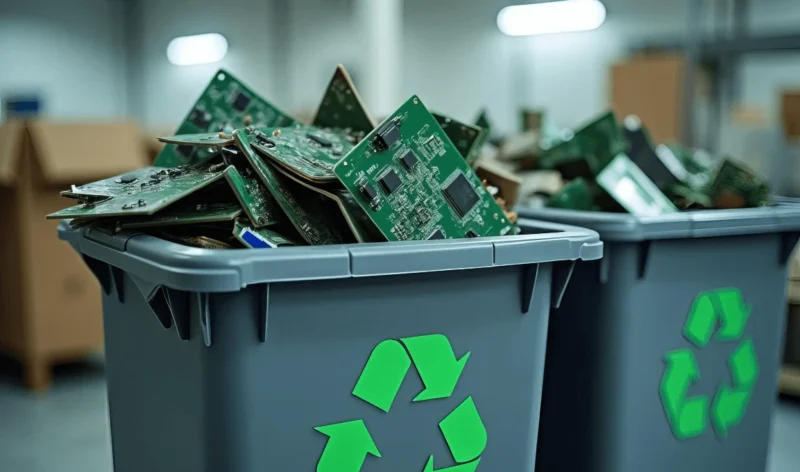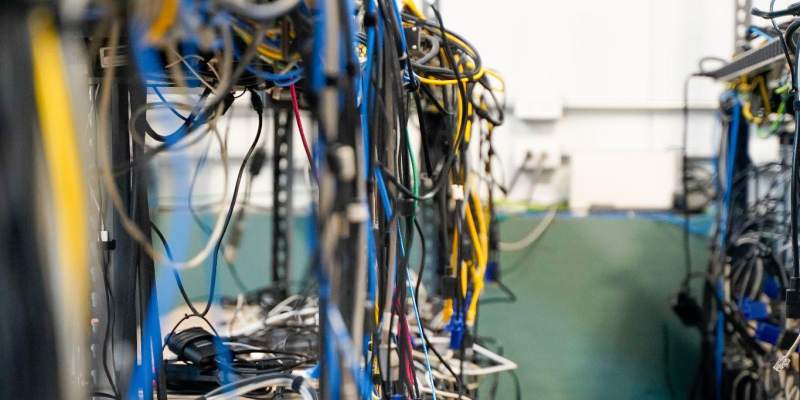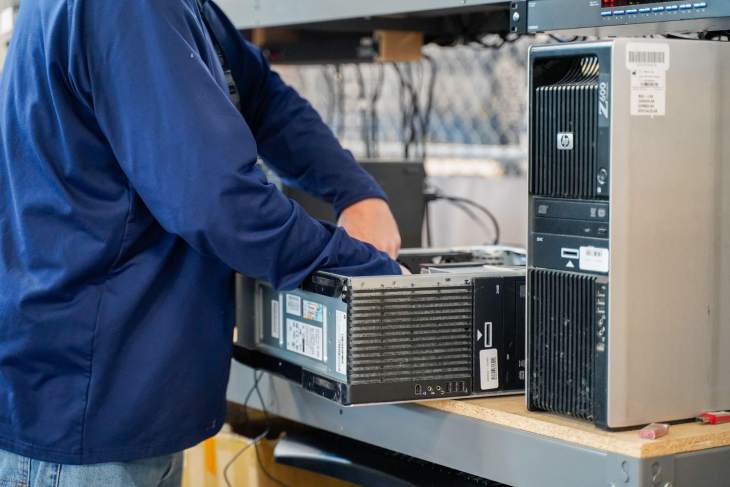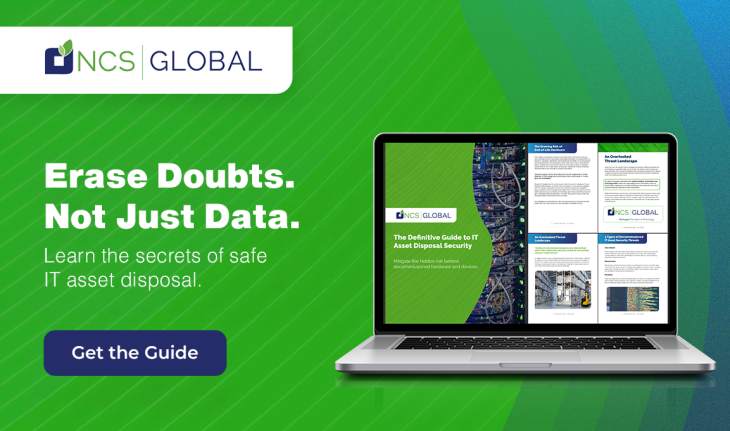Sustainable Approaches to Data Center Decommissioning

People don’t usually think about data centers as storehouses of hazardous waste, yet the servers, switches, and hard drives used in every data center on the planet contain heavy metals, batteries, and chemicals with the potential to contaminate the environment if not disposed of properly.
When companies decommission the outdated equipment in their data centers, it’s important that they follow a set of best practices to ensure that they’re following procedures that adequately protect our environment. In addition to trace amounts of toxic substances, IT equipment is made up of metals, plastics, and other materials that can be reclaimed for future use.
Government regulators, consumers, and investors are increasingly focused on sustainability. By responsibly decommissioning data centers, companies can assure compliance with environmental regulations and contractual obligations while also advancing their corporate objectives for social responsibility and sustainability.
Fortunately, the same practices that ensure sustainability are also essential to data security, and can help companies recapture value from their unwanted IT assets.
The Need for Sustainable Decommissioning
Decommissioning a data center involves the disassembly and disposition of large racks full of servers, storage devices, networking gear, and cooling systems. In addition to the electronic components already mentioned, data centers also use lead-acid or lithium-ion batteries, cooling fluids, and generators that may contain diesel fuel and other hazardous chemicals.
Improper disposal of these items can lead to environmental issues, including contamination of soil and water with hazardous materials like lead, mercury, and cadmium. The decommissioning process is time-consuming and can be risky if not done properly. Even the disassembly of rack servers and other hardware can present some risks because of the dust and debris generated throughout that process.
Dealing with these challenges in a responsible manner is critical because it directly impacts a company’s regulatory compliance requirements, contractual obligations, and corporate sustainability goals.
Numerous governments have rolled out laws and regulatory rules that dictate the handling of hazardous materials, including e-waste in particular. By following best practices in IT asset disposition (ITAD), companies can get ahead of the problem while also ensuring data security and returning some money to their bottom line.

Key Elements of Sustainable Data Center Decommissioning
ITAD service providers can help you achieve your sustainability goals as you decommission equipment, consolidate data centers, or shift to a cloud-first strategy:
Refurbishing equipment to extend its useful life: At a time when many organizations are looking to cut costs and operate at peak efficiency, it only makes sense to consider ways to extend the lifespan of your existing IT equipment. Before replacing an existing item, you should start by looking at options that could extend its useful life. ITAD companies have the expertise to refurbish and repair older IT equipment. This includes upgrading hardware, replacing worn-out components, and updating software to ensure the equipment meets certain standards and can effectively serve new users.
If you have equipment that you simply don’t intend to use anymore, the same ITAD service providers may be able to refurbish and resell it, returning value to your company’s bottom line. They can also facilitate donation of your used equipment to charity, which reflects positively on your organization and can generate tax benefits as well.
Recycling: Most IT equipment contains significant amounts of plastic, aluminum, steel, and other common materials that easily lend themselves to recycling. ITAD service providers can disassemble used equipment, salvage usable parts, and efficiently separate any recyclable components. This keeps those materials out of landfills while reducing the quantity of new raw materials needed by manufacturers.
Responsible disposal of hazardous materials: IT equipment contains circuit boards, toner, coolant, and other materials that must be processed carefully in order to maintain safety standards and comply with various environmental regulations. ITAD service providers extract as much reusable materials as possible and dispose of the remainder in a safe manner.
Energy-efficient decommissioning: The best ITAD companies follow an additional set of best practices aimed at reducing the carbon footprint of the decommissioning process itself. By optimizing transportation and logistics, for example, ITAD providers can reduce the carbon footprint associated with moving old equipment.
Best Practices for Sustainable Decommissioning
As with any major project, it makes sense to conduct a thorough environmental impact assessment before beginning the data center decommissioning process. Assemble a qualified team to assess the overall scope of the project and its potential environmental impact. Assess the various ecological risks associated with the decommissioning process and formulate an actionable approach to mitigating those risks.
Partner with a certified e-waste recycler or sustainable ITAD service provider to review and refine your decommissioning plan. Include measurable sustainability goals that align with your organization’s broader corporate responsibility objectives and ESG reporting commitments. Consider how you might use the project as a springboard for publicly communicating your company’s successes and commitment to a cleaner environment. Consumers and corporate customers alike are expressing a preference for doing business with companies that embrace environmentally responsible practices. Telling the world about your successes is good business.

Case Studies: Success Stories in Sustainable Decommissioning
When a global shipping provider set out to decommission multiple data centers on the same day, they needed to ensure 100% data security by shredding their existing hard drives. NCS Global helped them wipe, destroy, and properly dispose of drives from 2 data centers using our proprietary data destruction process. Those procedures guaranteed 100 percent data security and prevented 4,655.65 pounds of greenhouse gas emissions.
We help companies with all kinds of IT asset disposition scenarios to meet their objectives in an environmentally responsible way. When one of the world’s largest technology companies wanted to improve their sustainability metrics, NCS Global helped them responsibly disposition their unwanted equipment, protecting the environment through conservation, recycling, energy-saving, and emission avoidance. The company has reduced its carbon footprint by around 2,254 tons of greenhouse gases per year, and has benefited greatly from our zero-landfill recycling program.
These are just two of the many success stories that NCS Global is proud to tell. As more and more companies shift their IT workloads from locally controlled data centers to the cloud, the challenges of environmentally responsible data center decommissioning are evident.
Whether your organization is decommissioning a data center or simply managing a fleet of laptops, printers, and other devices, ITAD best practices can help you disposition your electronic equipment in an environmentally responsible way, while also ensuring absolute data security and return money to your bottom line. To learn more about how your organization can benefit from these practices, contact one of our experts today.
